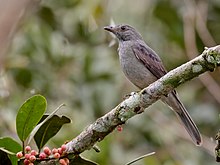Screaming piha
The screaming piha (Lipaugus vociferans) is a species of passerine bird in the family Cotingidae. It is found in humid forests in the Amazon and tropical parts of the Mata Atlântica in South America.[2] It is a common bird in the middle and lower parts of the canopy at altitudes below about 500 m (1,600 ft), or up to 1,000 m (3,300 ft) in Venezuela and the Andean foothills. It is adapting well to human settlement areas like gardens and parks, and is considered to be of least concern by BirdLife International.[1]
| Screaming piha | |
|---|---|
 | |
| Manaus, Amazonas, Brazil | |
| Song recorded in Tambopata Reserve, Madre de Dios Region, Peru | |
| Scientific classification | |
| Kingdom: | Animalia |
| Phylum: | Chordata |
| Class: | Aves |
| Order: | Passeriformes |
| Family: | Cotingidae |
| Genus: | Lipaugus |
| Species: | L. vociferans |
| Binomial name | |
| Lipaugus vociferans (Wied, 1820) | |
The screaming piha grows to a length of about 25 cm (10 in). Both sexes have dull grey plumage (wings and tail often somewhat duskier) and the underparts are paler grey. Juveniles are grey tinged with brown or rust.[3]
It has a voice that is extraordinarily loud,[4] reaching 116 dB, second only to that of the white bellbird.[5][6] In the breeding season, up to ten males may gather in loose leks, where they sing to attract females. The Cofán people of Ecuador call it the Pwe-pwe Yoh, which is a reference to its voice. Among the Ecuadorian Secoyas, the bird is known as the Kwow-kwee-yo. The sound is frequently used in movies as a sound typical of the Amazon rainforest.[7]
Despite its distinctive voice, the screaming piha is an elusive bird, remaining still for long periods and blending in with the branches. It is usually solitary, but may sometimes join a mixed species foraging group. It feeds mainly on fruits, but also consumes insects, sometimes flying out from its perch to pluck a fruit or catch an insect in the air with a trogon-like hover.[3]
References
- BirdLife International (2012). "Lipaugus vociferans". IUCN Red List of Threatened Species. 2012. Retrieved 26 November 2013.CS1 maint: ref=harv (link)
- "Screaming Piha - Lipaugus vociferans". www.arthurgrosset.com. Retrieved 2019-10-25.
- Ridgely, Robert S.; Tudor, Guy (2009). Field Guide to the Songbirds of South America: Vol. II, The Suboscine Passerines. University of Texas Press. p. 762. ISBN 978-0-292-71748-0.
- NEMETH, ERWIN (2004-01-01). "Measuring the Sound Pressure Level of the Song of the Screaming Piha Lipaugus Vociferans: One of the Loudest Birds in the World?". Bioacoustics. 14 (3): 225–228. doi:10.1080/09524622.2004.9753527. ISSN 0952-4622.
- Podos, Jeffrey; Cohn-Haft, Mario (2019-10-21). "Extremely loud mating songs at close range in white bellbirds". Current Biology. 29 (20): R1068–R1069. doi:10.1016/j.cub.2019.09.028. ISSN 0960-9822. PMID 31639347.
- "This is the world's 'loudest bird'". BBC News. Retrieved 2019-10-25.
- "Screaming Piha - Lipaugus vociferans - Birds of the World". birdsoftheworld.org. Retrieved 2020-05-26.
External links
- Recordings on the Screaming piha. xeno-canto America. Accessed 2008-07-10
- Screaming Piha recording British Library. Accessed 2018-09-28
- Screaming pihas on Freesound. Freesound.org. Accessed 2012-03-10
- Screaming piha entry in the Cornell Lab of Ornithology Neotropical Birds Encyclopedia. neotropical.birds.cornell.edu. Accessed 2012-11-23
